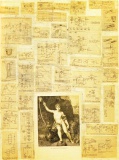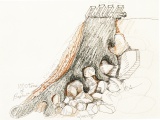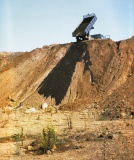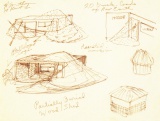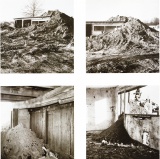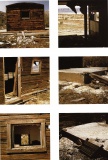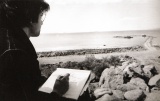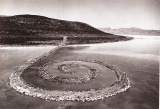Difference between revisions of "Robert Smithson"
m (Text replacement - "imagesize = 342px" to "imagesize = 338px") |
(→Books) |
||
| Line 192: | Line 192: | ||
* Ann Reynolds, ''[http://archive.org/details/0262182270ByAnnMorrisReynolds2002 Robert Smithson: Learning from New Jersey and Elsewhere]'', MIT Press, 2003, 384 pp. | * Ann Reynolds, ''[http://archive.org/details/0262182270ByAnnMorrisReynolds2002 Robert Smithson: Learning from New Jersey and Elsewhere]'', MIT Press, 2003, 384 pp. | ||
* Philip Ursprung, ''Grenzen der Kunst: Allan Kaprow und das Happening. Robert Smithson und die Land Art'', Munich: Silke Schreiber, 2003. {{de}} | * Philip Ursprung, ''Grenzen der Kunst: Allan Kaprow und das Happening. Robert Smithson und die Land Art'', Munich: Silke Schreiber, 2003. {{de}} | ||
| − | ** ''Allan Kaprow, Robert Smithson, and the Limits to Art'', trans. Fiona Elliott, University of California Press, 2013, 342 pp. [http://www.ucpress.edu/book.php?isbn=9780520245419] | + | ** ''[http://library.memoryoftheworld.org/#/book/674f2971-a619-4bdc-a6d5-911e0b247d8d Allan Kaprow, Robert Smithson, and the Limits to Art]'', trans. Fiona Elliott, University of California Press, 2013, 342 pp. [http://www.ucpress.edu/book.php?isbn=9780520245419 Publisher]. |
* Eugenie Tsai (ed.), ''Robert Smithson'', University of California Press, 2004, 248 pp. Exh. catalogue; with contributions by Alexander Alberro, Suzaan Boettger, Cornelia Butler, Thomas Crow, Mark Linder, Ann Reynolds, Jennifer L. Roberts, Moira Roth, Richard Sieburth, Robert A. Sobieszek, and Eugenie Tsai. [http://www.ucpress.edu/book.php?isbn=9780520244092] | * Eugenie Tsai (ed.), ''Robert Smithson'', University of California Press, 2004, 248 pp. Exh. catalogue; with contributions by Alexander Alberro, Suzaan Boettger, Cornelia Butler, Thomas Crow, Mark Linder, Ann Reynolds, Jennifer L. Roberts, Moira Roth, Richard Sieburth, Robert A. Sobieszek, and Eugenie Tsai. [http://www.ucpress.edu/book.php?isbn=9780520244092] | ||
* Jennifer L. Roberts, ''Mirror Travels: Robert Smithson and History'', Yale University Press, 2004. | * Jennifer L. Roberts, ''Mirror Travels: Robert Smithson and History'', Yale University Press, 2004. | ||
Revision as of 13:17, 11 August 2022
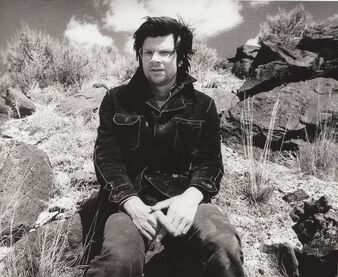 Smithson at the site of Spiral Jetty, Great Salt Lake, Utah, April 1970. Photo Gianfranco Gorgoni. | |
| Born |
January 2, 1938 Passaic, New Jersey, United States |
|---|---|
| Died |
July 20, 1973 (aged 35) Amarillo, Texas, United States |
| Web | UbuWeb, Aaaaarg, Wikipedia, Academia.edu |
Robert Smithson (1938–1973) was an American sculptor and writer associated with the Land Art movement. His large-scale sculptures, called Earthworks, engaged directly with nature and were created by moving and constructing with vast amounts of soil and rocks.
Contents
Biographical note
Excerpted from 'Biographical Note' printed in Smithson, The Collected Writings, ed. Jack Flam, 1996, pp xxvi-xxviii, itself a revised version of a text written by Nancy Holt, Philip Leider and Sol LeWitt for the first edition of the book (published 1979).
Robert Smithson was born in Passaic, New Jersey, on January 2, 1938. His parents, Susan Duke Smithson and Irving Smithson, moved back to his father's hometown, Rutherford, New Jersey, shortly after his birth. Robert Smithson was an only child—his nine-year-old brother, Harold, died of leukemia two years before he was born. [...]
In 1956, one week after graduating from high school, Srmthson joined the army reserves, where he was assigned to Special Services. His six-month period of active duty was spent in Fort Knox, Kentucky, where, after basic training, he was made artist-in-residence, doing posters for the camp and murals for the mess hall. He eventually obtained a discharge from the reserves on the grounds that continued service would ruin his creativity. Between 1956 and 1958 he hitchhiked extensively around the United States and Mexico.
Smithson's first one-man exhibition was of abstract paintings at the Artists Gallery, New York City, in 1959. In 1961 he had a one-man exhibition of paintings at Galleria George Lester, Rome, and in 1962 a one-man exhibition of assemblage works at the Richard Castellane Gallery, New York City. After this exhibition, he withdrew from the art world for a period of introspection and assessment, marrying the artist Nancy Holt in 1963. Smithson re-emerged in 1965 by showing sculpture at the Daniels Gallery, where he met various leading American sculptors of the 1960s. His first published writing on art appeared, and from this time on he continuously exhibited and wrote.
In 1966 he joined the Dwan Gallery, New York City, where he had four one-man exhibitions of sculpture between 1966 and 1970. At about the same time (1966-1969) he began excursions, usually with friends, sometimes alone, to New Jersey's decaying urban sites, industrial wastelands, and abandoned quarries. Out of this new consciousness of the postindustrial terrain emerged Smithson's Non-Sites, which created a wholly new premise for contemporary sculpture. It was in 1966 also that he proposed his first earthwork, Tar Pool and Gravel Pit, for Philadelphia, and other earthworks for the fringes of the Dallas-Fort Worth Regional Airport, as part of his work as an artist-consultant with an architectural firm that was competing for the airport design contract.
In the summer of 1968, he traveled to the deserts of California, Nevada, and Utah seeking sites for art. In 1969, in order to build a large work of art, he negotiated successfully with the government of British Columbia for a lease on an island near Vancouver. Later, however, the government's permission was rescinded, and the work was never built. Smithson was able, in 1969, to build Asphalt Rundown in a quarry near Rome, Italy. In 1970 he completed Partially Buried Woodshed, Kent, Ohio, and the Spiral Jetty in the Great Salt Lake, along with a film of the same name that revolves around that work.
From 1970 onward Smithson made many trips around the United States searching for sites for his work—the Florida Keys, Texas quarries, Salton Sea in California, Maine, and to islands on the Atlantic coast. He proposed many art works in the landscape that were ultimately rejected by various local sponsoring institutions. By reclaiming land in terms of earth art, he felt that art could be economically and politically integrated into society. In his mind this could best be accomplished by working with mining companies to reclaim devastated strip-mined land as earth art.
In 1971 he built Broken Circle-Spiral Hill in a quarry near Emmen, Holland, which was scheduled to be abandoned and returned to the people of the area. With this work Smithson realized his concern for recycling a mined site, in this case a sand quarry, into an art work. His desire to have art be a necessary part of society was gratified when the people of Emmen voted to keep and maintain the work after its completion.
From 1971 to 1973, he wrote to and visited many strip-mining companies, making drawings and proposals for landscape works. He also wrote public statements that pointed out the limiting confines of the art establishment. The mining industry unfortunately was not very far-sighted, and rejected Smithson's proposals.
Finally, a few weeks before his death, Smithson visited Creede, Colorado, where he had his first opportunity to propose a project for a tailings site to an interested mining company. Since the company was not ready to begin the project right away, Smithson traveled to a desert lake he had heard of in Amarillo, Texas. He decided that it was an excellent site for what was to be his last work, Amarillo Ramp, which was commissioned by the owner of the property. After trying out various ideas and dimensions, Smithson staked out Amarillo Ramp in its final form. On July 20, 1973, while he and a photographer were photographing the staked-out work from the air, the plane they were in crashed on a rocky hillside a few hundred feet from the site of the art, killing the pilot, the photographer, and Robert Smithson.
Documentation
Films
- with Nancy Holt, Mono Lake, 1968.
- East Coast West Coast, 1969.
- Spiral Jetty, 1970.
- with Nancy Holt, Swamp, 1971.
- Hotel Palenque, 1969. Bootleg film; documentation; artwork by Alex Hubbard.
Publications
(in English unless noted otherwise)
Articles
Almost all of the articles listed below are also reprinted in their original English versions in Smithson, The Collected Writings, 1996.
- "Donald Judd," in 7 Sculptors, Philadelphia Institute of Contemporary Art, 1965; repr. in Writings, 1979, pp 21-23.
- "The Crystal Land", Harper's Bazaar 3054, May 1966, pp 72-73; repr. in Writings, 1979, 19-20.
- "Entropy and the New Monuments", Artforum 5:10, Jun 1966, pp 26-31; repr. in Writings, 1979, 9-18; repr. in The Collected Writings, 1996, PDF.
- "Entropía y los nuevos monumentos", in Smithson, Selección de escritos, Alias, 2009, pp 15-30. (Spanish)
- "Interpolation of the Enantiamorphic Chambers", in Art in Process: The Visual Development of a Structure, New York: Finch College Museum of Art, 1966; repr. in Writings, 1979, pp 39-40.
- with Mel Bochner, "The Domain of the Great Bear", Art Voices 5:4, Fall 1966, p 44-51; repr. in Writings, 1979, pp 24-31.
- "Quasi-Infinities and the Waning of Space", Arts Magazine 41:1, Nov 1966, pp 28-31, JPGs; repr. in Writings, 1979, pp 32-36.
- "Language to be Looked at and/or Things to be Read", Dwan Gallery Press Release, Jun 1967; repr. in Writings, 1979, p 104.
- "Towards the Development of an Air Terminal Site", Artforum 6:10, Jun 1967, pp 36-40; repr. in Writings, 1979, pp 41-47.
- "Ultramoderne", Arts Magazine 42:1, Sep/Oct 1967, pp 31-33; repr. in Writings, 1979, pp 48-51.
- "Letter to the Editor", Artforum 6:2, Oct 1967, p 4; repr. in Writings, 1979, p 38.
- "Some Void Thoughts on Museums", Arts Magazine 42:2, Nov 1967, p 41; repr. in Writings, 1979, p 58.
- "The Monuments of Passaic", Artforum 7:4, Dec 1967, pp 48-51; repr. in Writings, 1979, pp 52-57.
- "What is a Museum? A Dialogue with Allan Kaprow", Arts Yearbook, 1967, pp 94-107; repr. in Writings, 1979, pp 59-66.
- "A Museum of Language in the Vicinity of Art", Art International 12:3, Mar 1968, pp 21-27; repr. in Writings, 1979, pp 67-78.
- "The Establishment", Metro 14, Jun 1968; repr. in Writings, 1979, pp 79-80.
- "Minus Twelve", in Minimal Art: A Critical Anthology, ed. Gregory Battcock, New York: E.P. Dutton, 1968, pp 402-406; repr. in Writings, 1979, p 81.
- "A Sedimentation of the Mind: Earth Projects", Artforum 7:1, Sep 1968, pp 44-50; repr. in Writings, 1979, pp 82-91.
- "Aerial Art", Studio International 175:89, Feb-Apr 1969, pp 180-181; repr. in Writings, 1979, pp 92-93.
- "Incidents of Mirror - Travel in the Yucatan", Artforum 8:1, Sep 1969, pp 28-33; repr. in Writings, 1979, pp 94-103.
- "Strata: A Geophotographic Fiction", Aspen 8, Fall/Winter 1970-71; repr. in Writings, 1979, pp 129-131.
- "The Spiral Jetty", Dwan Gallery, poster for film in the form of a storyboard, 1970.
- "A Cinematic Atopia" Artforum, 10:1, Sep 1971, pp 53-55; repr. in Caderno Sesc Videobrasil 3, São Paulo: Associação Cultural Videobrasil, 2007, pp 70-73.
- "Atopia cinemática", in Caderno Sesc Videobrasil 3, São Paulo: Associação Cultural Videobrasil, 2007, pp 66-69. (Brazilian Portuguese)
- "The Spiral Jetty", in Arts of the Environment, ed. Gyorgy Kepes, New York: G. Braziller, 1972, pp 222-232; repr. in Writings, 1979, pp 109-116.
- "El malecón espiral", trans. Nely Coarasa, El arte del ambiente, Buenos Aires: Victor Leru, 1978. (Spanish)
- "Cultural Confinement", Artforum 11:2, Oct 1972, p 32; repr. in Writings, 1979, pp 132-133.
- "Hotel Palenque, 1969-1972" [1972], Parkett 43, 1995, pp 117-132. Lecture given to architecture students at the University of Utah, 1972. (English)/(German)
- "Frederick Law Olmstead and the Dialectical Landscape", Artforum 11:6, Feb 1973, pp 62-68; repr. in Writings, 1979, pp 117-128.
- "The Establishment", Documentario, Jan 1993, pp 78-79.
Interviews
Almost all of the interviews listed below are also reprinted in their original English versions in Smithson, The Collected Writings, 1996.
- "An Interview" [20 Mar 1968], intro. Irving Sandler, ed. Alexander Nagel, RES 63-64 (Spring/Autumn 2013).
- Anthony Robbins, "Smithson's Non-Sites Sights", Art News 67:10, Feb 1969, p 50; repr. in Writings, 1979, pp 157-159.
- Thomas Leavitt, "Earth" [Feb 1969], Writings, 1979, pp 160-167. Symposium at White Museum, Cornell University.
- William C. Lipke, "Fragments of a Conversation" [Feb 1969], Writings, 1979, pp 168-170.
- P.A. Norvell, "Robert Smithson: Fragments of An Interview with P.A. Norvell, April, 1969", eds. Lucy R. Lippard and Robert Smithson, in Lucy R. Lippard, Six Years: The Dematerialization of the Art Object, New York: Praeger, 1973, pp 87-90
- Dennis Wheeler, "Four Conversations between Dennis Wheeler and Robert Smithson, December 1969-January 1970", in Robert Smithson Unearthed, ed. Tsai, 1991, pp 93-126.
- Paul Toner, "Interview with Robert Smithson", 1970.
- [Liza Bear, Willoughby Sharp], "Discussion with Heizer, Oppenheim, Smithson", Avalanche 1:1, Fall 1970, pp 48-71; repr. in Writings, 1979, pp 171-178.
- Gregoire Mueller, "... Earth, Subject to Cataclysms, Is a Cruel Master", Arts Magazine 46:2, Nov 1971, pp 36-41; repr. in Writings, 1979, pp 179-185.
- Bruce Kurtz, "Conversation with Robert Smithson on April 22nd 1972", The Fox II, 1975, pp 72-76; repr. in Writings, 1979, pp 200-204.
- Paul Cummings, "Interview with Robert Smithson for the Archives of American Art/Smithsonian Institution" [14 & 19 Jul 1972], Writings, 1979, pp 137-156.
- Gianni Pettena, "Conversation in Salt Lake City", Domus 516, Nov 1972, pp 53-56; repr. in Writings, 1979, pp 186-188.
- Moira Roth, "Robert Smithson on Duchamp: An Interview", Artforum 12:2, Oct 1973, p 47; repr. in Writings, 1979, pp 197-199.
- Alison Sky, "Entropy Made Visible", On Site 4, Fall 1973, p 26-30; repr. in Writings, 1979, pp 189-196.
- "Spiral Jetty", movie treatment photo from John Weber Gallery, New York.
- "Absurd View", 1970, drawing.
- "Robert Smithson's Amarillo Ramp", Avalanche 8, Fall 1973.
- "The Spiral Jetty", Big Deal 3, New York City, p 3.
- Boettger, Suzaan, "Robert Smithson", interview by Willoughby Sharp (1969), Art in America, New York, Dec 1998, pp 75-81.
- Lucy R. Lippard, "Out of the Past: Lucy Lippard Talks about Eva Hesse with Nancy Holt and Robert Smithson," ArtForum, 2008. Reprinted.
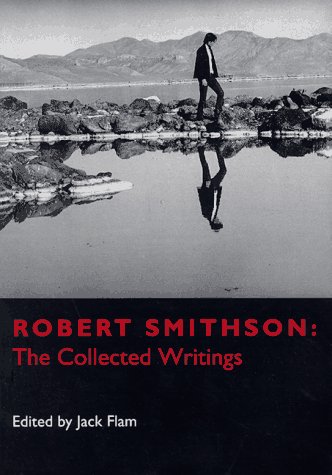
Collected works, writings and interviews
- The Writings of Robert Smithson, ed. Nancy Holt, New York University Press, 1979; rev. & exp. ed. as The Collected Writings, ed. & intro. Jack Flam, University of California Press, 1996, xxviii+389 pp.
- Robert Smithson: izbor tekstova, ed. Zoran Gavrić, trans. Branislava Belić, Belgrade: Muzej savremene umetnosti, 1983, 40 pp. Trans. of selected texts from 1979 edition. (Serbo-Croatian)
- Robert Smithson: gesammelte Schriften, eds. Eva Schmidt and Kai Vöckler, trans. Christoph Hollender and Gaby Hartel, Cologne: Walther König, 2000, 355 pp. (German)
- Robert Smithson Unearthed: Drawings, Collages, Writings, ed. Eugenie Tsai, Columbia University Press, 1991.
- Robert Smithson Slide Works, ed. Guglielmo Bargellesi, 1997. Text by Vicki Goldberg, Carlo Frua.
- Robert Smithson: Spiral Jetty, eds. Lynne Cooke and Karen Kelly, University of California Press / DIA Art Foundation, 2005.
- Selección de escritos, ed. Sara Schulz, trans. María Orvañanos and Eva Quintana Crelis, Alias, 2009, 186 pp. Selection of writings from 1966-73. (Spanish)
- Τέσσερα Κείμενα, Topovoros, 2013. Includes four texts by Smithson. (Greek)
Bibliography
Literature
Books
- Robert Hobbs, Robert Smithson: Sculpture, Cornell University Press, 1981. With contributions by Lawrence Alloway, John Coplans, Lucy R. Lippard.
- Gary Shapiro, Earthworks: Robert Smithson and Art After Babel, University of California Press, 1995.
- Ann Reynolds, Robert Smithson: Learning from New Jersey and Elsewhere, MIT Press, 2003, 384 pp.
- Philip Ursprung, Grenzen der Kunst: Allan Kaprow und das Happening. Robert Smithson und die Land Art, Munich: Silke Schreiber, 2003. (German)
- Allan Kaprow, Robert Smithson, and the Limits to Art, trans. Fiona Elliott, University of California Press, 2013, 342 pp. Publisher.
- Eugenie Tsai (ed.), Robert Smithson, University of California Press, 2004, 248 pp. Exh. catalogue; with contributions by Alexander Alberro, Suzaan Boettger, Cornelia Butler, Thomas Crow, Mark Linder, Ann Reynolds, Jennifer L. Roberts, Moira Roth, Richard Sieburth, Robert A. Sobieszek, and Eugenie Tsai. [1]
- Jennifer L. Roberts, Mirror Travels: Robert Smithson and History, Yale University Press, 2004.
- Ron Graziani, Robert Smithson and the American Landscape, Cambridge University Press, 2004.
- Simon Dell, Alistair Rider, William Wood, On Location: Siting Robert Smithson and His Contemporaries, London: Black Dog Publishing, 2009.
- Ingrid Commandeur, Trudy van Riemsdijk-Zandee (eds.), Robert Smithson: Art in Continual Movement, Amsterdam: Alauda Publications, 2012, 240 pp. [2]
Book chapters, articles
- Virginia Dwan, "Reflections on Robert Smithson", Art Journal 42:3 (1982), p 233.
- Thomas Dreher, "Robert Smithson: Land Reclamation and the Sublime", trans. Gerard A. Goodrow and Andreas Fritsch, Arte Factum 45, Oct/Nov 1992, pp 26-30.
- Neville Wakefield, "Yucatan is Elsewhere: On Robert Smithson's Hotel Palenque / Yucatan ist anderswo. Ueber Robert Smithson Hotel Palenque", trans. Susanne Schmidt, Parkett 43, 1995, p 133-138. (English)/(German)
- Marga Bijvoet, "Robert Smithson: In Search of a Different Paradigm for Sculptural Space", ch. 5 in Bijvoet, Art As Inquiry: Toward New Collaborations Between Art, Science, and Technology, Peter Lang, 1997.
- "Robert Smithson: Ein neuer Raum für die Skulptur", ch. 5 in Bijvoet, Kunst-Forschung, n.d. (German)
- Andrew V. Uroskie, "La Jetée en Spirale: Robert Smithson's Stratigraphic Cinema", Grey Room 19, Spring 2005, pp 54-79.
